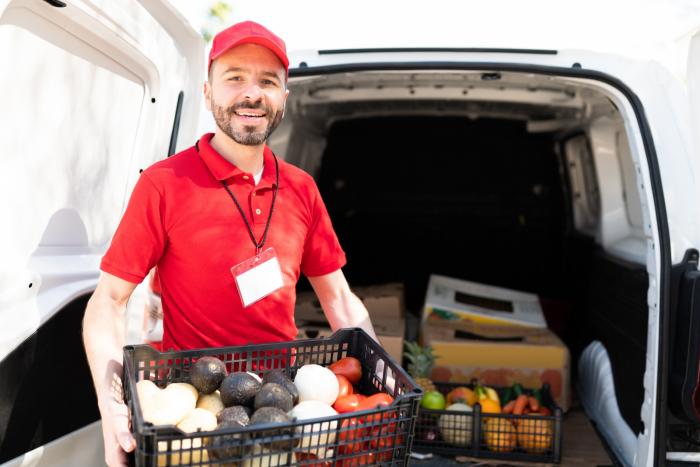Edible Food Recovery
What is the SB 1383 Edible Food Recovery requirement?

To reduce unnecessary food waste and help address food insecurity, SB 1383 requires California to recover 20% of edible food, that would have otherwise been sent to landfills, and redistribute or donate to those in need by 2025.
Specifically, the law requires the following:
- Jurisdictions must establish edible food recovery outreach and inspection programs to help connect edible food generators with food recovery organizations and services that can redistribute or donate edible food to those in need.
- Jurisdictions are responsible for ensuring there is sufficient county-wide capacity to recover and redistribute all edible food.
- Certain edible food generators must arrange to recover the maximum amount of their edible food that would otherwise go to landfills by establishing contracts with food recovery organizations and services and keeping records of all edible food donated.
- Food recovery organizations and services that work with edible food generators must maintain and submit records of donated edible food they have collected.
What is edible food? Edible food is food intended for people to eat, including food not sold because of appearance, age, freshness, grade, surplus, etc. Edible food includes, but is not limited to, prepared foods, packaged foods, and produce. All edible food must meet the food safety requirements of the California Retail Food Code (PDF).
What does “food recovery” mean? Food recovery means collecting edible food that would otherwise go to waste and redistributing it to feed people in need. This is the highest and best use for food that would otherwise go to waste. Feeding hungry people through food recovery is the best use for surplus food and a vital way for California to conserve resources and reduce waste thrown in landfills.
Information for Edible Food Generators
SB 1383 requires certain businesses that are defined as either a “Tier 1” or “Tier 2” edible food generator to meet the SB 1383 edible food recovery requirements. The types of businesses that fall under the Tier 1 and Tier 2 categories, and when they must become compliant, are described below.
To assist Tier 1 and Tier 2 edible food generators, the City of Garden Grove, Garden Grove Sanitary District, and Republic Services are working with Abound Food Care to help local businesses implement food recovery programs. Abound Food Care will be reaching out to Tier 1 and Tier 2 facilities.
Since 2012, Abound Food Care has provided system wide solutions to help edible food generators channel excess edible food to communities rather than landfills. By reducing food insecurity and food waste, we’re improving the health of our communities and the environment. Visit our website, www.aboundfoodcare.org, to begin your donations to help end hunger and food waste.
Tier 1 Edible Food Generators
These entities are required to comply with edible food recovery requirements starting January 1, 2022:
- Grocery stores – Stores that are 10,000 square feet or more in size and primarily engaged in the retail sale of canned food, dry goods, fresh fruits and vegetables, fresh meats, fish, and poultry. Any area that is not separately owned within the store where the food is prepared and served, including a bakery, deli, or meat and seafood department must also comply.
- Supermarkets - Full-line, self-service, retail stores with gross annual sales $2,000,000 or more that sell a line of dry grocery, canned goods, or non-food items, and some perishable items.
- Food service providers - Entities primarily engaged in providing food services to institutional, governmental, commercial, or industrial locations through a contractual arrangement with the organization.
- Food distributors - Companies that distributes food to entities including, but not limited to, supermarkets and grocery stores.
- Wholesale food vendors – Businesses engaged in the wholesale distribution of food, where food is received, shipped, stored, or prepared for distribution to a retailer, warehouse, distributor, or other destination.
Tier 2 Edible Food Generators
These entities are required to comply with edible food recovery requirements starting January 1, 2024:

- Restaurants with 250 or more seats, or a total facility size equal to or greater than 5,000 square feet.
- Hotels with an on-site food facility and 200 or more rooms.
- Health facilities with an on-site food facility and 100 or more beds.
- Large venues - Permanent venue facilities that annually seat or serve an average of more than 2,000 individuals within the grounds of the facility per day of operation. A venue facility includes, but is not limited to, a public, nonprofit, or privately owned or operated stadium, amphitheater, arena, hall, amusement park, conference or civic center, zoo, aquarium, airport, racetrack, horse track, performing arts center, fairground, museum, theater, or other public attraction facility. A site under common ownership or control that includes more than one large venue that is contiguous with other large venues in the site, is a single large venue.
- Large events - Events, including, but not limited to, a sporting event or a flea market, that charge an admission price, or are operated by a local agency, and serve an average of more than 2,000 individuals per day of operation of the event, at a location that includes, but is not limited to, a public, non-profit, or privately owned park, parking lot, golf course, street system, or other open space when being used for an event.
- State agencies with a cafeteria that seats 250 or more, or has a total cafeteria facility size equal to or greater than 5,000 square feet.
- Local education agencies with an on-site food facility.
To meet SB 1383 requirements Tier 1 and Tier 2 edible food generators must:

-
Recover (for human consumption) the maximum amount of edible food that would otherwise be disposed of. This can be accomplished by donating or paying for the food to be recovered by a food recovery organization or service. Food recovery organizations and services includes, but are not limited to food banks, food pantries, soup kitchens, for-profit food recovery services, and other non-profits that distribute food to people in need.
- Edible food generators may also give away excess food to employees, take it home for personal use, or give it away to customers, etc.
-
Not intentionally spoil edible food that is capable of being recovered by a food recovery organization or service.
-
Establish contracts or written agreements with food recovery organizations and services. Food recovery organizations and services vary in the amount and types of food they can receive, so edible food generators may need to establish contracts or written agreements with multiple food recovery organizations and services to be in compliance. CalRecycle has developed a Model Food Recovery Agreement that can be used as an example. These contracts can include the establishment of a regular edible food delivery or collection schedule, identifying allowable edible foods for recovery, and cost-sharing options.
-
Maintain the following records of their food recovery activities:
- A list of each food recovery service or organization that collects or receives its edible food under a contract or written agreement.
- The name, address, and contact information of each food recovery service or organization contracted with.
- Copies of contracts or written agreements between the edible food generator and a food recovery service or organization.
- The types of food that will be collected by or self-hauled to each food recovery service or organization.
- The established frequency that food will be collected or self-hauled to each food recovery service or organization.
- The quantity of food collected or self-hauled to each food recovery service or organization for food recovery. The quantity shall be measured in pounds recovered per month.
-
For large venue or large event operators that do not provide food services, but allow for food to be provided, require food facilities operating at the large venue or large event to comply with the SB 1383 edible food recovery requirements.
-
Annually, provide jurisdictions with the following records for review to meet compliance monitoring requirements:
- Contracts or written agreements with food recovery organizations and services.
- Schedules for food recovery deliveries or collections.
- Quantities of food recovered in pounds per month.
- Types of food each food recovery organization will receive or collect.
How can businesses be protected from liability?
The “Bill Emerson Good Samaritan Food Donation Act” (Public Law 104-210) makes it easier for businesses to donate to food recovery organizations and services by protecting donors from liability when donating to nonprofit organizations. The act protects donors from civil and criminal liability should the product donated in good faith cause harm to the needy recipient.
Food Recovery Organizations Serving the City of Garden Grove
Bracken’s Kitchen – (714) 554-1923
Abound Food Care – (657) 335-4480
Community Action Partnership Korean Senior Center – (714) 667-0717
Grandma's House of Hope – (714) 458-4172
Helping Others Prepare for Eternity - (714) 539-4357
International Crusade of the Penny – (714) 818-7839
Padres Unidos – (714) 616-8423
Calvery Chapel West Grove Food Distribution – (714) 745-4212
Information for Food Recovery Organizations and Food Recovery Services:

SB 1383 requires Tier 1 and Tier 2 edible food generators to recover (for human consumption) the maximum amount of their edible food that would otherwise be disposed. Food recovery organizations and services can support the state in meeting SB 1383 requirements by contracting with edible food generators to collect and distribute or donate edible food to those in need.
What is a Food Recovery Organization and Food Recovery Service?
- Food recovery organization: An entity that engages in the collection or receipt of edible food from Tier 1 and Tier 2 edible food generators and distributes that edible food to the public for food recovery either directly or through other entities including, but not limited to, food banks, non-profit charitable organizations, or non-profit charitable temporary food facilities.
- Food recovery service: A person or entity that collects and transports edible food from a Tier 1 or Tier 2 edible food generator to a food recovery organization or other entity for food recovery.
Requirements for food recovery organizations and food recovery services:
Food recovery organizations and services are not required to participate in state mandated food recovery efforts under SB 1383. However, if a food recovery organization or service does decide to participate by working with a Tier 1 or Tier 2 edible food generator, they are required to:
- Enter into a written agreement or contract with the Tier 1 or Tier 2 edible food generator. CalRecycle has developed a Model Food Recovery Agreement that can be used as an example. The contract or written agreement can include:
- Establishing a regular food recovery delivery or collection schedule,
- Identifying allowable foods for recovery, and
- Cost-sharing options (food recovery organizations and services do not need to accept recovered food for free, they can decide to charge for their collection/recovery services).
- Report the total pounds recovered from Tier 1 and Tier 2 edible food generators in the previous calendar year to the jurisdiction where their primary address is physically located. The jurisdiction will in turn report to CalRecycle the pounds collected to measure statewide progress toward achieving 20% edible food recovery goal.
- Maintain additional records as described below.
Recordkeeping requirements for Food Recovery Organizations:

Food recovery organizations must maintain the following records to meet SB 1383 requirements for food recovery:
- The name, address, and contact information for each Tier 1 or Tier 2 edible food generator that the organization receives edible food from.
- The quantity in pounds of edible food received from each Tier 1 or Tier 2 edible food generator per month.
- The name, address, and contact information for each food recovery service that the organization receives edible food from for food recovery.
Recordkeeping requirements for Food Recovery Services:
Food recovery services must maintain the following records to meet SB 1383 requirements for food recovery:
- The name, address, and contact information for each Tier 1 or Tier 2 edible food generator that the service collects edible food from.
- The quantity in pounds of edible food collected from each Tier 1 or Tier 2 edible food generator per month.
- The quantity in pounds of edible food transported to each food recovery organization per month.
- The name, address, and contact information for each food recovery organization that the service transports edible food to for food recovery.
This webpage will continue to be updated as more information becomes available.
More information for food recovery organizations is available on CalRecycle’s website.
Resources Available
- CalRecycle Model Food Recovery Agreement
- SB 1383 Education and Outreach Materials
- Grants and Funding Opportunities
Tier 1 Edible Food Generator Letter
Food Recovery Organizations
For information on Food Recovery Organizations and the items the accept, please refer to the list below:
